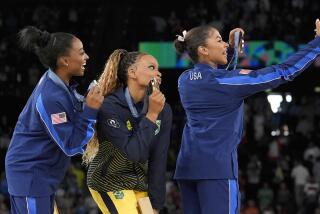Hundreds of Women Cover Sports
- Share via
Fewer than half a dozen women writers covered professional football, baseball, basketball and hockey in early 1970 and none were allowed in the locker rooms to interview players. But by the mid-’70s, matters had changed, at least in hockey and basketball.
Hockey reporter Robin Herman of the New York Times probably was the first female journalist to interview players in the locker room while covering the New York Islanders in 1973-74, said Tracy Dodds, vice president of the Assn. for Women in Sports Media.
Now, the AWSM has almost 400 sportswriter members covering professional and college sports, Dodds said, adding, “there are another 300 to 400 out there.”
There had been few “reported” locker room problems for women until the Sept. 17 incident involving New England Patriot players and Boston Herald football reporter Lisa Olson. “But I guarantee you, somewhere today, in college or pros, some woman is being verbally abused and humiliated” in a locker room, said Dodds, of the Orange County Register.
In 1974, the National Hockey League became the first pro sports organization to institute an “equal access” policy for male and female sportswriters. NHL locker rooms are open to accredited writers up to 90 minutes before games. After games there is a 10-minute “cooling-off period” before the press is permitted in the locker room, said the NHL’s Michael Berger.
The National Basketball League developed “an open-door, equal-access policy” for reporters in the mid-’70s, said the NBA’s Terry Lyons. “We have simple rules,” he said, adding that the media are “allowed in (locker rooms) up until 45 minutes before a game. . . . We also have the 10-minute cooling-off period after a game and it’s worked quite well. We’ve had no incidents and no fines.”
Major league baseball and the National Football League held out as “male only” locker rooms until 1978 and 1985, respectively.
But in 1977, Melissa Ludtke, then a Sports Illustrated reporter covering the New York Yankees in the World Series, was refused the clubhouse access given to male sportswriters. Ludtke, Sports Illustrated and its parent, Time Inc., sued the Yankees, alleging that Ludtke had suffered sex discrimination.
On Sept. 25, 1978, a federal judge ruled that barring women writers from locker rooms violated the Constitution. She ordered the Yankees to protect players’ privacy while allowing equal access to male and female reporters. (The judge suggested towels might help.)
In pro baseball, the league media policy allows all reporters access “immediately after games,” said a spokesman for the commissioner who did not recall “in recent memory” fines for noncompliance.
Until 1985, NFL clubs developed their own policies on female reporters in locker rooms. Since then, league policy allows locker room access to all accredited reporters.
But Cincinnati Bengals coach Sam Wyche, who barred USA Today sports reporter Denise Tom from his team’s locker room after its Oct. 1 loss to the Seahawks in Seattle, was fined $3,000 by the league last year for barring all reporters from the locker room after another Seattle loss. Wyche also received a 1988 warning from former NFL commissioner Pete Rozelle for limiting locker room access.
Paul Tagliabue, the current commissioner, has said he will fine Wyche heavily for the Monday incident. Tagliabue also has appointed a Harvard Law School professor as special counsel to investigate Olson’s sexual harassment allegations against the Patriots.
More to Read
Go beyond the scoreboard
Get the latest on L.A.'s teams in the daily Sports Report newsletter.
You may occasionally receive promotional content from the Los Angeles Times.










